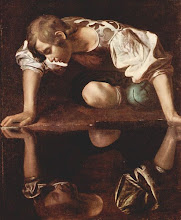 In the life of Ceolfrith in his Lives of the Abbots of Wearmouth and Jarrow, Bede says of Ceolfrith:
In the life of Ceolfrith in his Lives of the Abbots of Wearmouth and Jarrow, Bede says of Ceolfrith:For, among other arrangements which he found it necessary to make, during his long government of the monastery, he built several oratories increased the number of vessels of the church and altar and the vestments of every kind; and the library of both monasteries, which Abbot Benedict had so actively begun under his equally zealous care became doubled in extent For he added three Pandects of a new translation to that of the old translation which he had brought from Rome; one of them, returning to Rome in his old age, he took with him as a gift; the other two he left to the two monasteries.
One of these bibles Ceolfrith took to Rome still survives as the Codex Amiatinus, which ended up in a monastery (it is not known quite how) on Mount Amiata (hence the name). It stayed there for the best part of a thousand years until the monastery was closed in 1780, when the Codex Amiatinus was taken to the Biblioteca Medicea Laurenziana, where it remains today. This article gives more details about the history of the Codex, including the story of how it was discovered to be one of Ceolfrith's Bibles.
A replica of the Codex was given in to the city of Sunderland in 2004 to commemorate the city's adoption of Benedict Biscop, the founder of the monaster of Wearmouth and Jarrow, as its patron saint. A 2001 congress in Florence called "The City and the Book" included two papers on the Codex Amiatinus, one, with illustrations, from the Director of the Biblioteca Medicea Laurenziana, and the other from Lucia Castaldi, arguing, amongst others, for Bede's involvement in the production of the Codex, a view which Michelle of Heavenfield firmly rejects in this blog entry.

This page shows the handwriting in the Codex Amiatinus and another handwritten page is discussed here.
To put the Codex into a wider context, this page comes from a series on insular manuscripts, including the Book of Durrow, which I blogged on earlier. (public domain images from wiki commons)





No comments:
Post a Comment